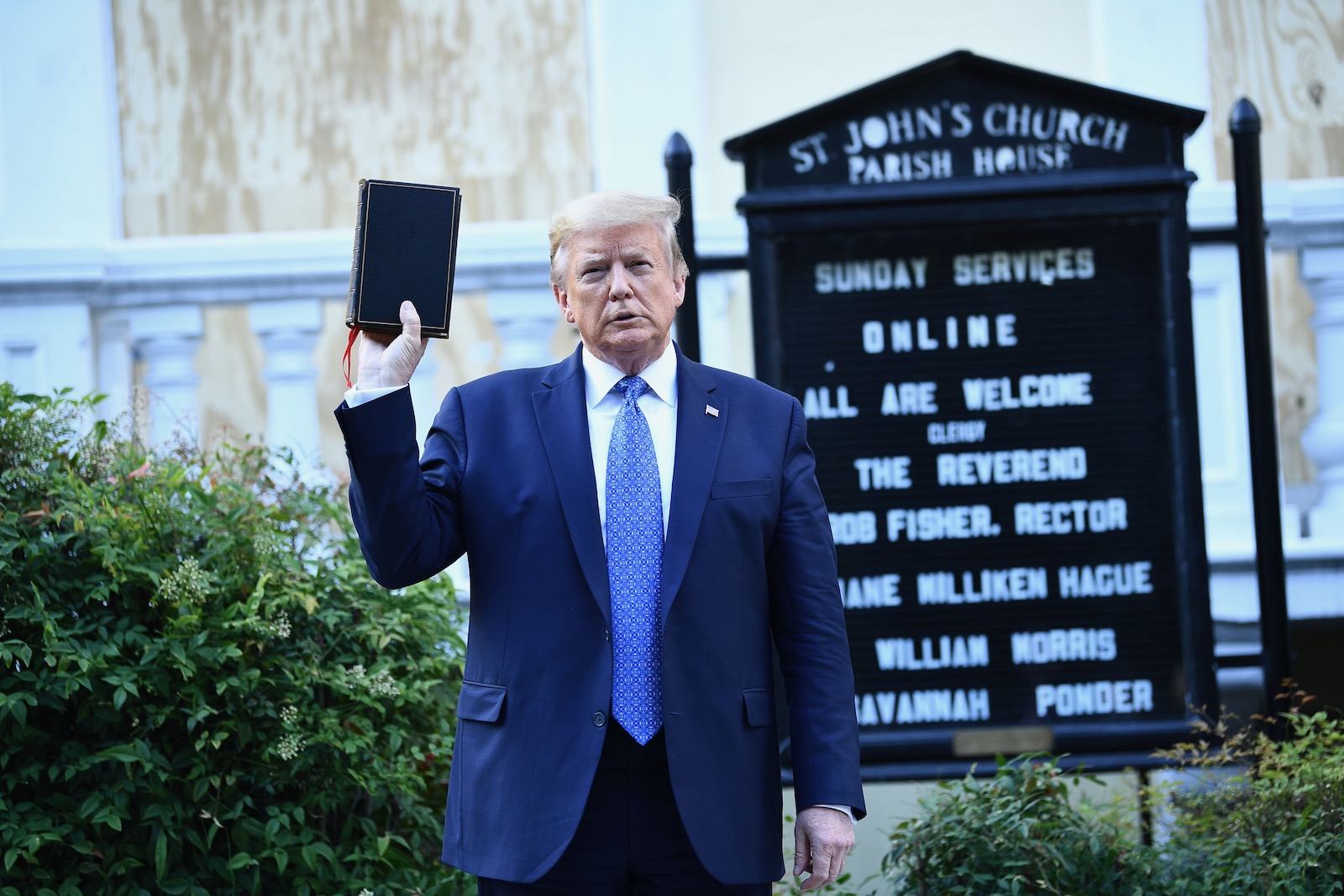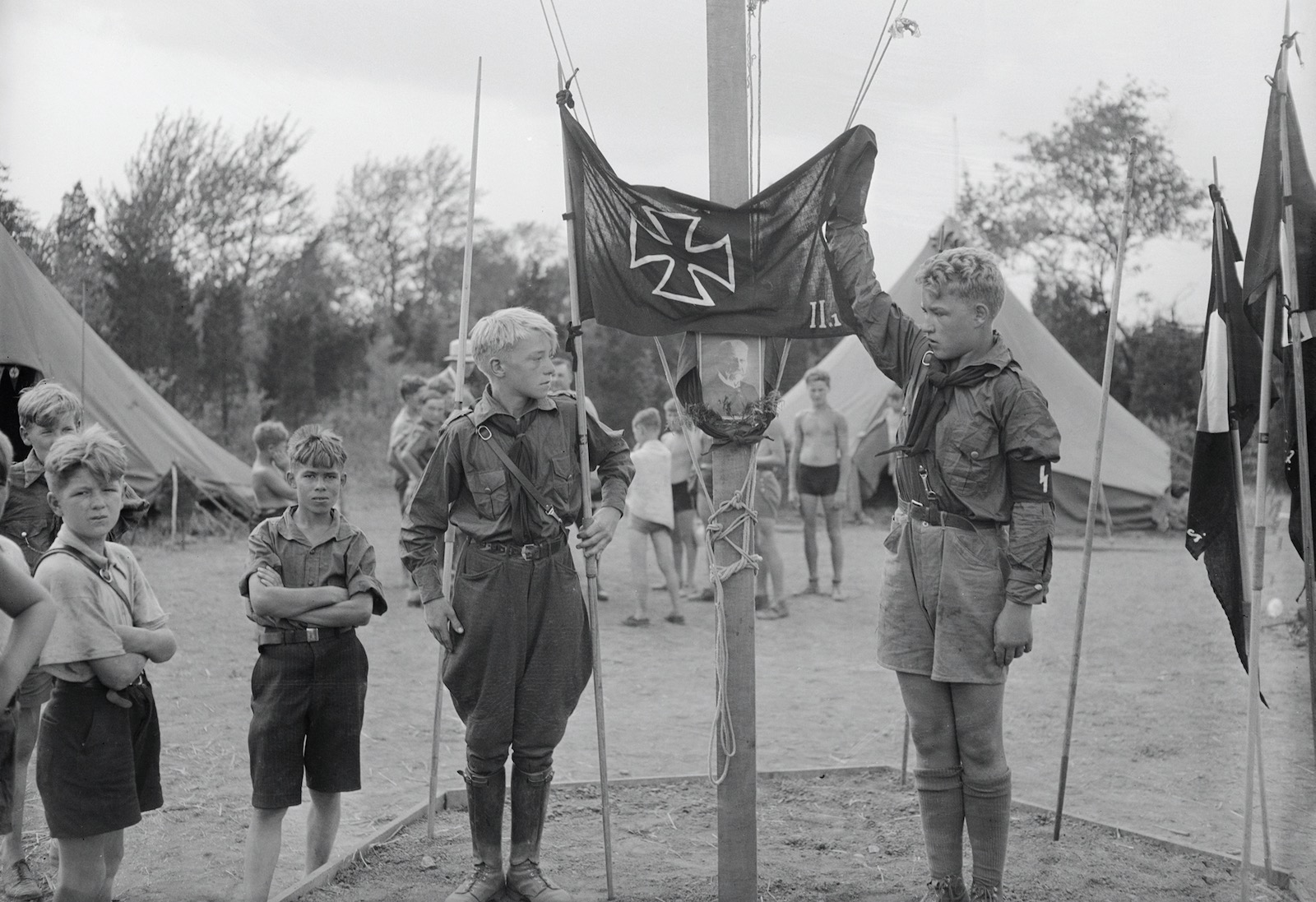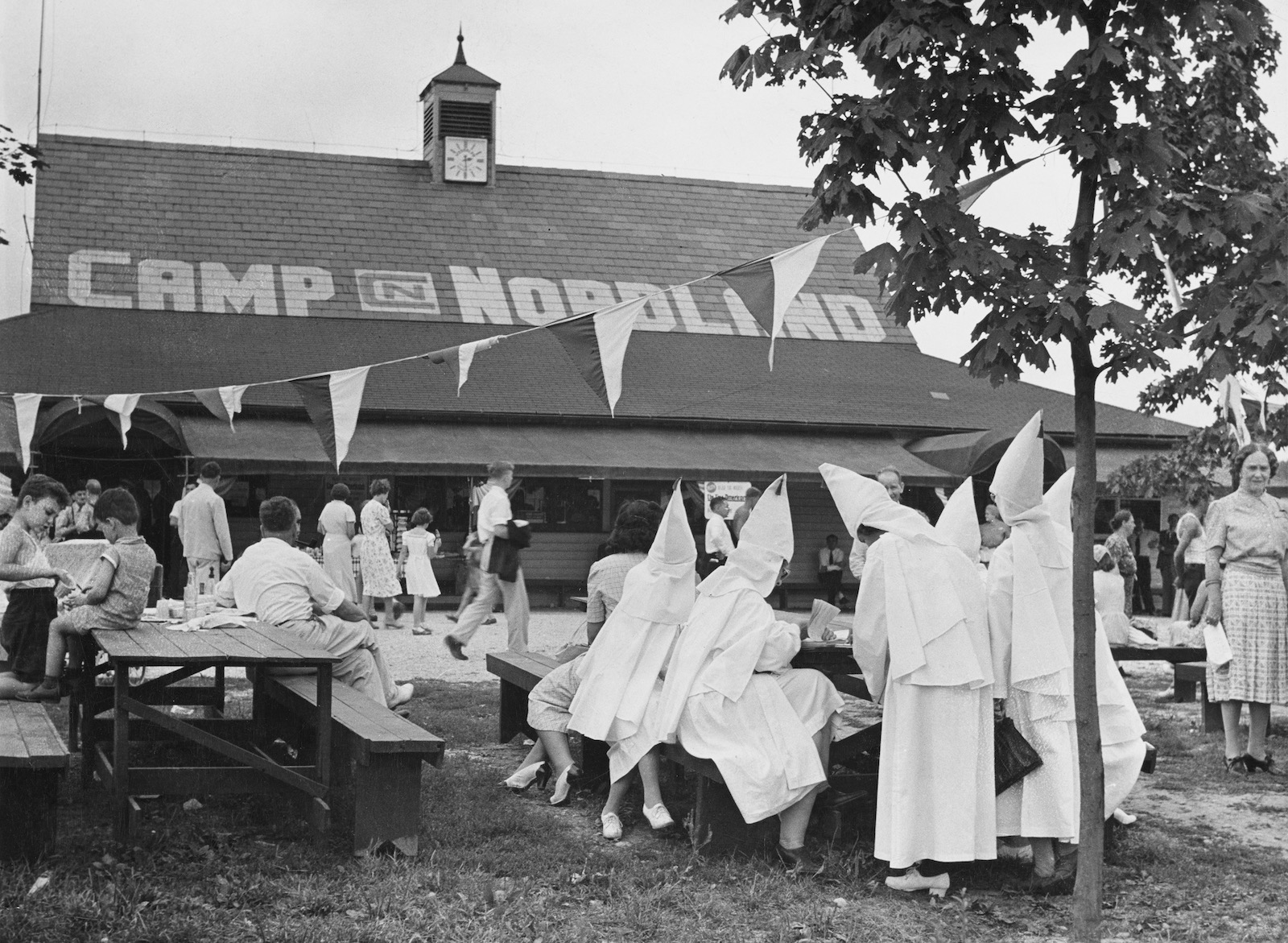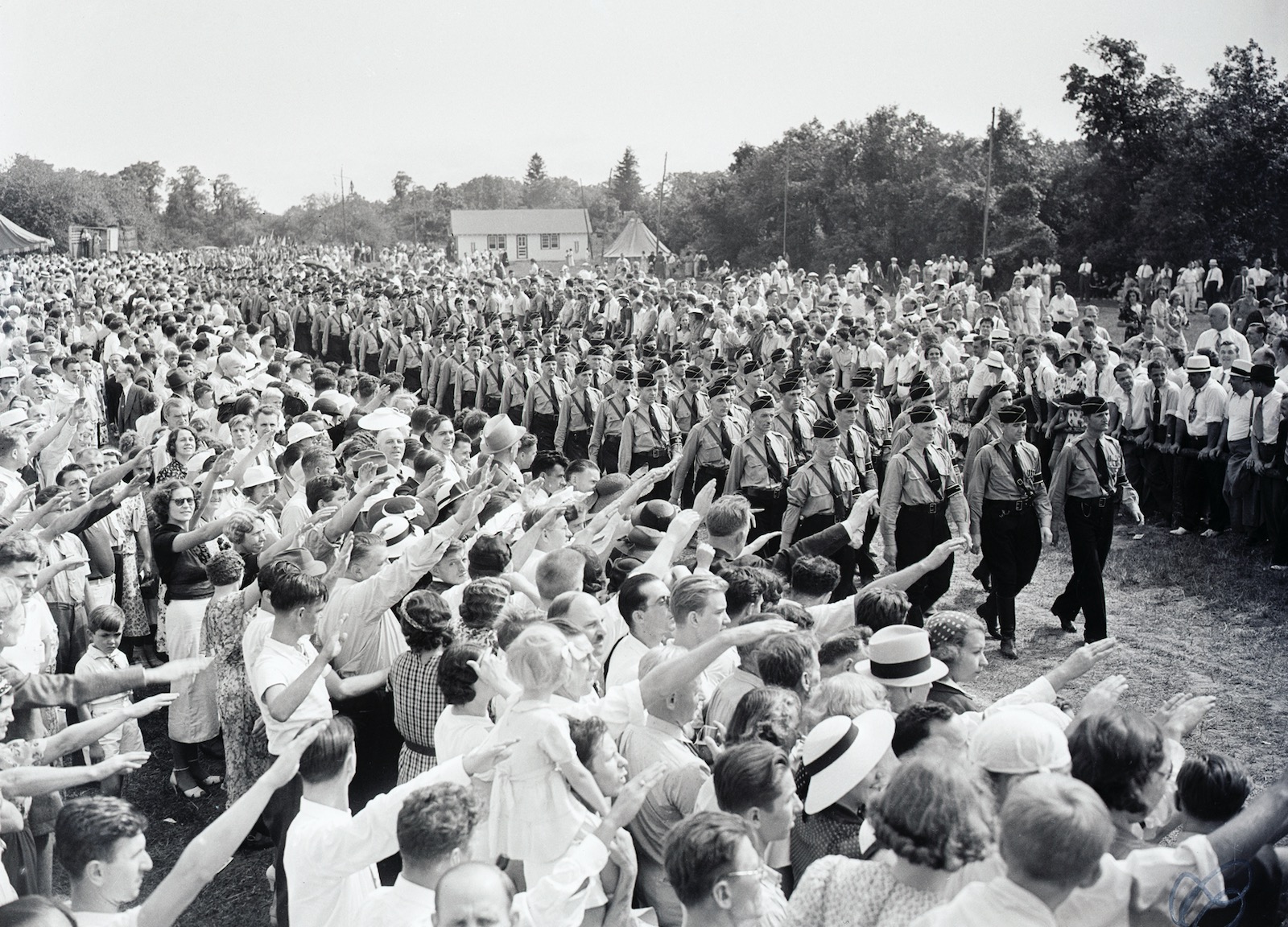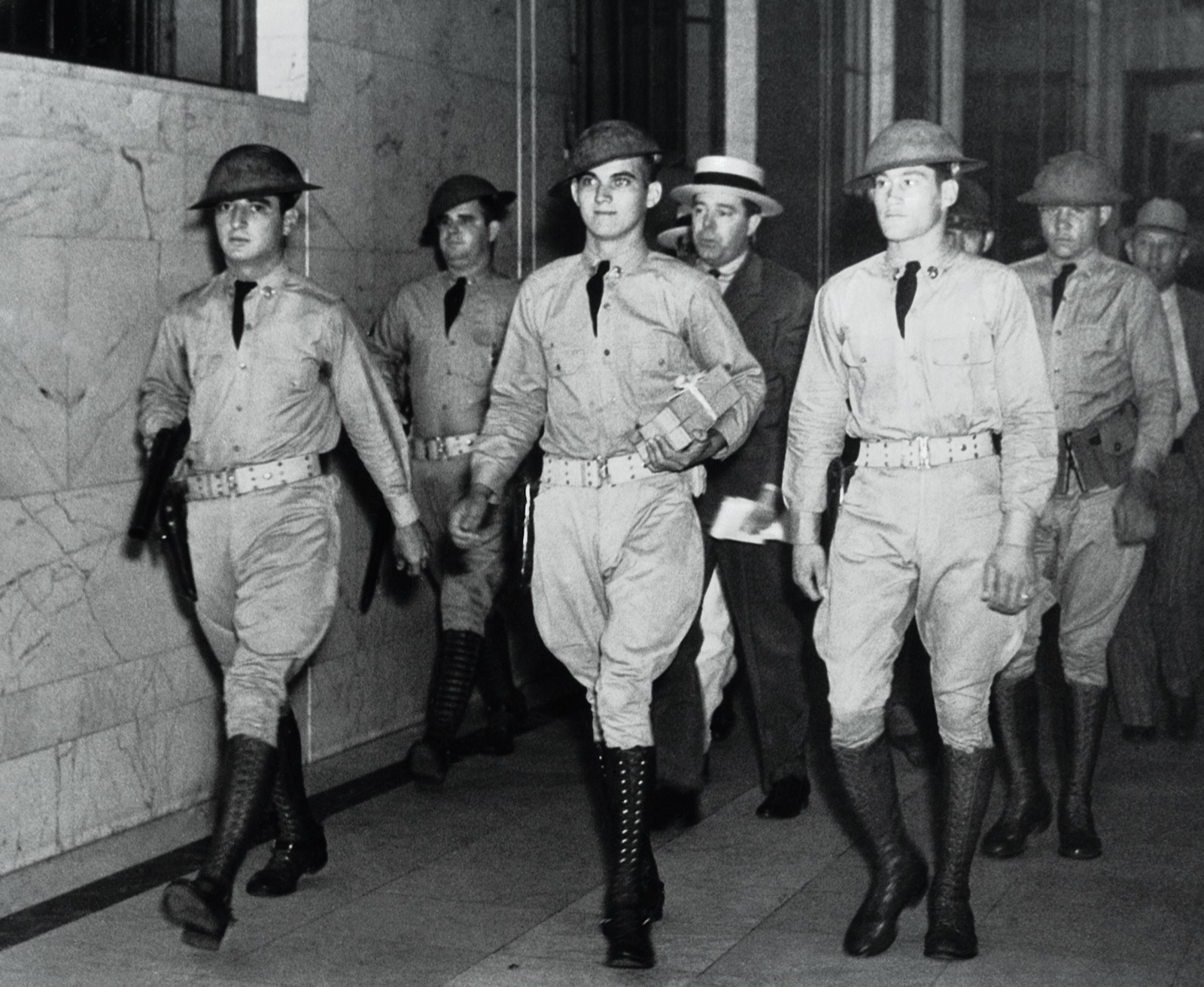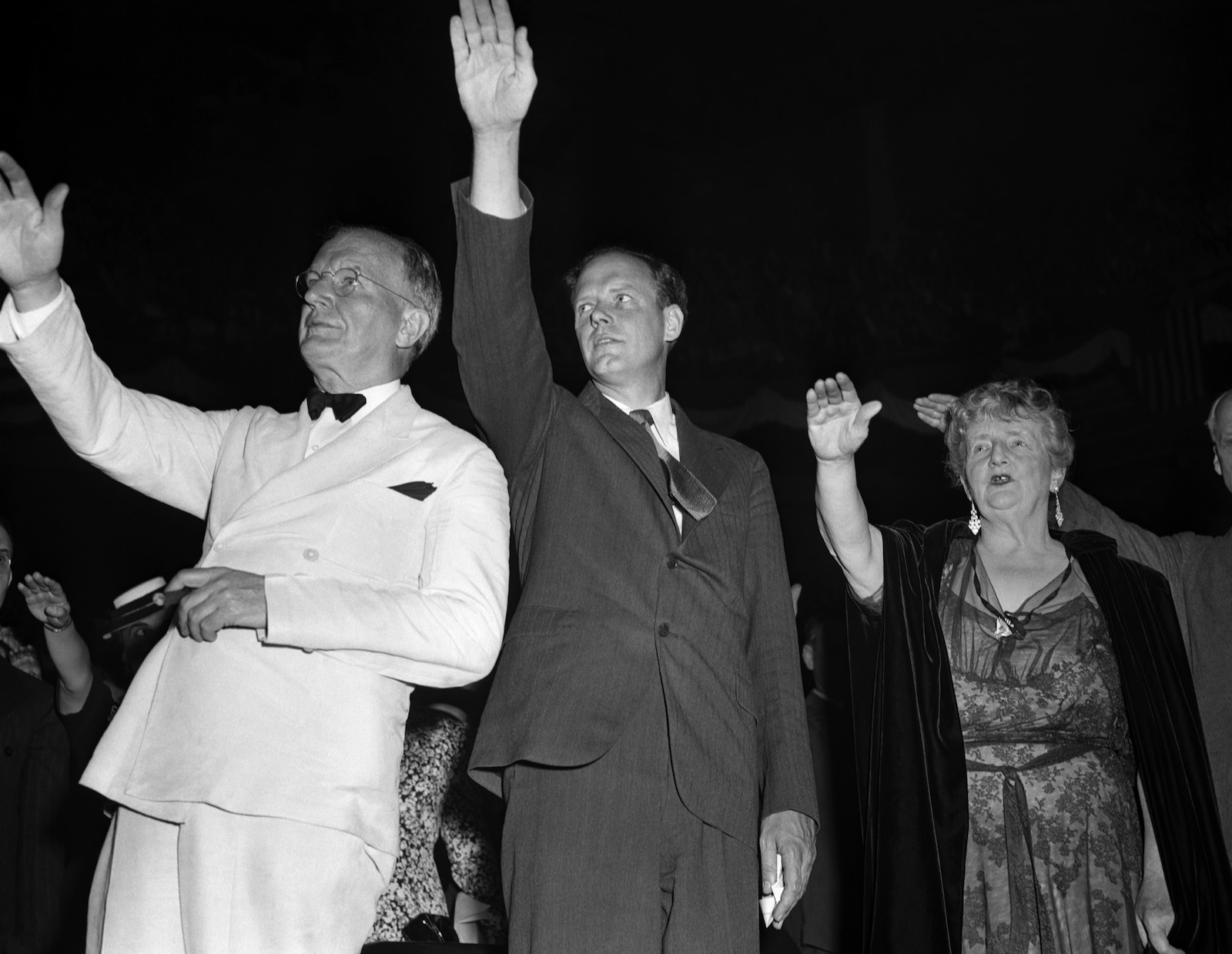As militarized police in riot gear and armored vehicles barreled into peaceful protesters in cities across America, and its president emerged from a bunker to have citizens tear-gassed on his way to a church he’d never attended, holding a Bible he’d never read, many people recalled a famous saying often misattributed to Sinclair Lewis’s 1935 novel It Can’t Happen Here: “When fascism comes to America, it will be wrapped in the flag and carrying a cross.” Because Lewis’s novel is the best remembered of the many warnings against American fascism in the interwar years, he has latterly been credited with the admonition, but they are not Lewis’s words.
The adage probably originated instead with James Waterman Wise, son of the eminent American rabbi Stephen Wise and one of the many voices at the time urging Americans to recognize fascism as a serious domestic threat. “The America of power and wealth,” Wise cautioned, is “an America which needs fascism.” American fascism might emerge from “patriotic orders, such as the American Legion and the Daughters of the American Revolution… and it may come to us wrapped in the American flag or a Hearst newspaper.” In another talk that year, he put it slightly differently: American fascism would likely come “wrapped up in the American flag and heralded as a plea for liberty and preservation of the constitution.”
An American fascism would, by definition, deploy American symbols and American slogans. “Do not look for them to raise aloft the swastika,” Wise warned, “or to employ any of the popular forms of Fascism” from Europe. Fascism’s ultra-nationalism means that it works by normalizing itself, drawing on familiar national customs to insist it is merely conducting political business as usual. As José Antonio Primo de Rivera, the leader of Spain’s proto-fascist Falange party, proclaimed in 1934, all fascisms ought to be local and indigenous:
Italy and Germany… turned back towards their own authenticity, and if we do so ourselves, the authenticity which we find will also be our own: it will not be that of Germany or Italy, and therefore, by reproducing the achievement of the Italians or Germans we will become more Spanish than we have ever been… In fascism as in movements of all ages, underneath the local characteristics there are to be found certain constants… What is needed is a total feeling of what is required: a total feeling for the Fatherland, for life, for History.
Samuel Moyn recently argued in these pages against comparing Trump’s policies to fascism, because his administration is “pursuing causes with roots deep in American history. No analogy to Hitler or fascism is needed to explain these results.” But this presumes that fascism does not have its own deep roots in American history. It is arguable—not to say, exceptionalist—to presuppose that anything indigenously American cannot be fascist; this begs the question of American fascism rather than disputing it. Experts on fascism such as Robert O. Paxton, Roger Griffin, and Stanley G. Payne have long argued that fascism can never seem alien to its followers; its claims to speak for “the people” and to restore national greatness mean that each version of fascism must have its own local identity. To believe that a nationalist movement isn’t fascist because it’s native is to miss the point entirely.
Historically, fascist movements were also marked by opportunism, a willingness to say almost anything to get into power, rendering definitions even murkier. Trying to identify its core, the unsplittable fascist atom, has proved impossible; we are left with what Umberto Eco called fascism’s “fuzziness,” others its “hazy and synthetic doctrines.” There are good arguments against attempting through taxonomies to establish what’s become known as a “fascist minimum,” as if a checklist could qualitatively differentiate fascism from other authoritarian dictatorships. Some think anti-Semitism is a litmus test; others genocide. Does colonialism count? Aimé Césaire, C.L.R. James, and Hannah Arendt, among many other notable thinkers who lived through the first fascisms, certainly thought it did, arguing that European fascism visited upon white bodies what colonial and slave systems had perfected in visiting upon black and brown bodies.
Paxton has argued influentially that fascism is as fascism does. But conspicuous features are recognizably shared, including: nostalgia for a purer, mythic, often rural past; cults of tradition and cultural regeneration; paramilitary groups; the delegitimizing of political opponents and demonization of critics; the universalizing of some groups as authentically national, while dehumanizing all other groups; hostility to intellectualism and attacks on a free press; anti-modernism; fetishized patriarchal masculinity; and a distressed sense of victimhood and collective grievance. Fascist mythologies often incorporate a notion of cleansing, an exclusionary defense against racial or cultural contamination, and related eugenicist preferences for certain “bloodlines” over others. Fascism weaponizes identity, validating the herrenvolk and invalidating all the other folk.
Advertisement
Americans of the interwar period, though they could not predict what was to come in Europe, were nonetheless perfectly clear about one fact we have lost sight of today: all fascism is indigenous, by definition. “Fascism must be home grown,” admonished an American lecturer in 1937, “repeating the words of Benito Mussolini, that fascism cannot be imported,” but must be “particularly suited to our national life.” Logically, therefore, “the anti-Negro program” would provide “a very plausible rallying cry for American fascists,” just as anti-Semitism had for Germans. Others recognized that the deep roots of anti-Semitic evangelical Christianity provided equally plausible rallying cries for an American fascism. Wartime patriotism and the Allied triumph soon gave Americans permission to regard fascism as an alien and uniquely European pathology, but “the man on horseback,” the despot who could ride reactionary populist energies to power, had been a specter in American politics since at least as early as the presidency of Andrew Jackson in the 1830s.
*
One of the last, and most horrific, public lynchings in America took place in October 1934, in the Florida Panhandle, where a crowd of as many as 5,000 gathered to watch what had been advertised hours earlier in the local press. Claude Neal was burned and castrated, had his genitals stuffed into his mouth, and was forced to tell his torturers that he enjoyed their taste. After he was finally dragged to his death behind a car, his mutilated corpse was urinated upon by the crowds, and then hung from the Marianna Courthouse. The German press, quick to capitalize on reports of American lynching, circulated photographs of Neal, whose horrific death they described with “sharp editorial comments to the effect that America should clean its own house” before it censured other governments’ treatment of their citizens. “Stop Lynching Negroes is Nazi Retort to American Critics,” read the Pittsburgh Courier headline reporting German accounts of American racial violence.
The Courier was one of many African-American papers that not only saw affinities between Nazi Germany and Jim Crow America, but also traced causal connections. “Hitler Learns from America,” the Courier had declared as early as 1933, reporting that German universities under the new regime of the Third Reich were explaining that they drew their ideas from “the American pathfinders Madison Grant and Lothrop Stoddard,” and that “racial insanities” in America provided Nazi Germany with “a model for oppressing and persecuting its own minorities.” The African-American New York Age similarly wondered if Hitler had studied “under the tutelage” of Klan leaders, perhaps as “a subordinate Kleagle or something of the sort.”
The Nazis themselves saw a clear kinship. Recent histories have demonstrated that Hitler systematically relied upon American race laws in designing the Nuremberg laws, while the Third Reich also actively sought supporters in the Jim Crow South, although the political leadership of the white South largely did not return the favor. But the correspondence between the two systems was perfectly evident at the time, on both sides of the Atlantic. A Nazi consul general in California even tried to purchase the Klan, with the idea of plotting an American putsch. His price was too low—the Klan was nothing if not mercenary—but, as journalists remarked after the story came to light in 1939, the Klan could not afford to seem foreign; “to be effective,” its nativist agenda had to be pursued “in the name of Americanism.”
In 1935, African Americans organized around the country in mass protests against Mussolini’s slaughter of Ethiopians across the sea. “American Fascism Already Has Negroes,” declared the Jamaican-American journalist and historian Joel Augustus Rogers. Langston Hughes agreed: “Give Franco a hood and he would be a member of the Ku Klux Klan, a Kleagle. Fascism is what the Ku Klux Klan will be when it combines with the Liberty League and starts using machine guns and airplanes instead of a few yards of rope.” “In America, Negroes do not have to be told what fascism is in action,” Hughes told another audience. “We know.”
At the same time, in 1935, W.E.B. Du Bois published Black Reconstruction in America. This foundational work of African-American revisionist historiography appeared amid the tumult of the Scottsboro Nine’s persecution and as Jesse Owens’s medal haul at the Berlin Olympics was seen as both a joke against Hitler and a rebuke to Jim Crow America. In no way coincidentally, then, Du Bois implies in his study more than once that the white supremacism of Jim Crow America could indeed be regarded as “fascism.” A half-century later, in a neglected but remarkable essay, Amiri Baraka made Du Bois’s notion explicit, arguing that the end of Reconstruction “heaved Afro America into fascism. There is no other term for it. The overthrow of democratically elected governments and the rule by direct terror, by the most reactionary sector of finance capital… Carried out with murder, intimidation and robbery, by the first storm troopers, again the Hitlerian prototype, the Ku Klux Klan, directly financed by northern capital.” It would take another decade or so for white American historiography to absorb the argument, when, in 2004, Paxton observed in The Anatomy of Fascism that a strong argument could be made for the first Ku Klux Klan in the Reconstruction South being the world’s earliest fascist movement:
Advertisement
[The first Klan was] an alternative civic authority, parallel to the legal state, which, in the eyes of the Klan’s founders, no longer defended their community’s legitimate interests. By adopting a uniform (white robe and hood), as well as by their techniques of intimidation and their conviction that violence was justified in the cause of their group’s destiny, the first version of the Klan in the defeated American South was arguably a remarkable preview of the way fascist movements were to function in interwar Europe.
After the KKK was resurrected in 1915, the second Klan claimed as many as five million members by the mid-1920s, a degree of proliferation in American society that represented one out of every three or four white Protestant American men. When Mussolini burst onto the world stage in 1921, many Americans across the country instantly recognized his project, as newspapers from Montana to Florida explained to their readers that “the ‘Fascisti’ might be known as the Ku Klux Klan,” and “the klan… is the Fascisti of America.” Comparisons between the homegrown Klan and Italian fascism soon became ubiquitous in the American press; the resemblance was not superficial.
The second Klan disintegrated in the late 1920s under the taint of corruption and sex scandals, but some of its erstwhile leaders soon began cutting their bloodstained cloth to fit new political fashions. The majority of the American fascist groups of the interwar period, more than one of which self-identified as fascist, began not as branches of Nazism, but as offshoots of the Klan. Their Christian nationalism was inextricable from their anti-Semitism, although it also led to a sectarianism that may have kept them from forging stronger alliances.
Many of these groups shared the fondness of their European counterparts for dressing up in “colored shirt” uniforms, to suggest organized force and militaristic might, to intimidate and exclude, including Atlanta’s Order of Black Shirts; the White Shirts, militant “Crusaders for Economic Liberty,” founded by George W. Christians, who cultivated a toothbrush mustache and Hitlerian lock of flopping hair; the Gray Shirts, officially “The Pioneer Home Protective Association,” founded in upstate New York; the Khaki Shirts (also “US Fascists”); the Silver Shirts, which William Dudley Pelley modeled on Hitler’s “elite Nazi corps,” and the Dress Shirts. By the end of 1934, American journalists were mocking the growing list. “Gray Shirts Make America No. 1 Among Shirt-Nations,” read one sarcastic headline, noting that unless other countries began cheating by combining colors, “it will be impossible to out-shirt us.”
But others took the threat more seriously. As James Waterman Wise repeatedly explained, “the various colored shirt orders—the whole haberdashery brigade who play upon sectional prejudice,” were “sowing the seeds of Fascism” in the United States. The Black Legion was an offshoot of the Klan that flourished in the Midwest, whose leader spoke of seizing Washington in a revolutionary coup, called the New Deal a Jewish plot “to starve the Gentiles out,” and espoused the extermination of American Jews by means of poison gas dispensers in synagogues on Yom Kippur. Anyone wondering “what fascism would be like in this country” should look to the Black Legion, with its “odor of Hitlerism,” its “anti-Catholic, anti-Jewish, anti-Negro, anti-labor platform, its whips, clubs and guns, its brazen defiance of law and order and the due processes of democracy,” warned a widely syndicated 1936 editorial. “These are the attitudes and equipment of fascism.”
The short-lived “Friends of the Hitler Movement” soon transformed into the more acceptable “Friends of New Germany” in 1933, before becoming the Bund. It held several large rallies in Madison Square Garden, including its 1939 “Mass Demonstration for True Americanism,” where a giant banner featuring George Washington was flanked by swastikas, and twelve hundred “storm troopers” stood in the aisles delivering the Nazi salute; footage from the rally was restored in 2019 as the short film “A Night at the Garden.” By 1940, the Bund claimed membership of 100,000 and had established summer camps in upstate New York, New Jersey, and Long Island where it trained American Nazi youth. The Bund’s propagandist, Gerhard Kunze, reported at the time that “the swastika is not foreign but one hundred per cent American. The Indians always used it,” while the emblem of another group, “The American National-Socialist Party,” was “an American Indian, arm outstretched in salute, poised against a black swastika.” They admitted to working to naturalize Nazism, seeking consanguinities with American symbolism.
Then, too, there was Father Coughlin. “I take the road of Fascism,” he said in 1936, before forming the Christian Front,” whose members referred to themselves as “brown shirts.” His virulently anti-Semitic radio program, regularly transmitting claims from the fabricated Protocols of the Elders of Zion, reached almost 30 million Americans at its height—the largest radio audience in the world at the time. Those listeners tuned in at the end of 1938 as Coughlin was justifying the violence of Kristallnacht, arguing that it was “reprisal” against Jews who had supposedly murdered more than twenty million Christians and stolen billions of dollars in “Christian property”; Nazism, he said, was a natural “defense mechanism” against the communism financed by Jewish bankers. Coughlin’s weekly newspaper, Social Justice, which had an estimated circulation of 200,000 at its height, was described by Life magazine at the time as probably the most widely read voice of “Nazi propaganda in America.”
But the American leader most often accused of fascist tendencies was Huey Long. As Louisiana governor (and senator), Long imposed local martial law, censored the newspapers, forbade public assemblies, packed the courts and legislatures with his cronies, and installed his twenty-four-year-old lover as secretary of state. Long was a racketeer, but his “Share Our Wealth” program did improve local conditions, building roads and bridges, investing in hospitals and schools, and abolishing the poll tax. His economic populism was also not predicated on furthering racial, ethnic, or religious divisions; he subordinated his white supremacism to his redistributionist political message. “We just lynch an occasional nigger,” he breezily declared when dismissing anti-lynching laws, though he also recognized “you can’t help poor white people without helping Negroes,” and so was prepared for his rising tide to lift all boats. When Long set his sights on the 1936 presidential election, Franklin D. Roosevelt was sufficiently alarmed to inform his ambassador to Germany: “Long plans to be a candidate of the Hitler type for the presidency,” predicting that by 1940 Long would try to install himself as a dictator.
Roosevelt was hardly alone in fearing that Long sought to be an “American Fuehrer”; Long’s political career gave plenty of reason for doubting his democratic bona fides. He inspired Sinclair Lewis’s Buzz Windrip in It Can’t Happen Here, the president-dictator who promises Americans $5,000 a year if they vote for him, as Long had done. But the name Windrip also suggests Rev. Gerald B. Winrod, the “Kansas Hitler” who led the “Defenders of the Christian Faith” and had been touring the nation lecturing on the millenarian role of Hitler, Stalin, and Mussolini in Biblical prophecy since the late 1920s. That Lewis also viewed the Klan as a fascist movement is clear from an extended denunciation that opens the novel, in which Lewis rips through a genealogy of American proto-fascist tendencies, including anti-Semitism, political corruption, war hysteria, conspiracy theories, and evangelical Christianity, before ending on the “Kentucky night-riders,” the “trainloads of people [who] have to gone to enjoy lynchings.” “Not happen here?… Where in all history has there ever been a people so ripe for a dictatorship as ours!”
President Windrip himself is “vulgar, almost illiterate, a public liar easily detected, and in his ‘ideas’ almost idiotic.” His fascist regime, driven by Christian nationalism and a desire for ethnic homogeneity, turns both African Americans and Jews into enemies of the state, decreeing that all bankers are Jewish. It Can’t Happen Here suggests that in America, fascism’s most dangerous supporters would be those “who disowned the word ‘Fascism’ and preached enslavement to Capitalism under the style of Constitutional and Traditional Native American Liberty.” It would be “government of the profits, by the profits, for the profits.” Fascism’s cancerous version of nationalism means that an American fascism will always graft American pieties about individual liberty onto realities of systemic greed, printing “liberate” on flags waved by a huckster.
Dorothy Thompson, the celebrated journalist and anti-fascist campaigner and Sinclair Lewis’s wife at the time, similarly earned the sobriquet of “Cassandra” for prophesying that fascism in the US would look all too familiarly American when it arrived. (Thompson enjoyed the riposte that Cassandra was always proven right in the end.) “When Americans think of dictators they always think of some foreign model,” she said, but an American dictator would be “one of the boys, and he will stand for everything traditionally American.” And the American people, Thompson added, “will greet him with one great big, universal, democratic, sheeplike bleat of ‘O.K., Chief! Fix it like you wanna, Chief!’” A year later, a Yale professor named Halford Luccock was also widely cited in the press when he told an audience: “When and if fascism comes to America it will not be labeled ‘made in Germany’; it will not be marked with a swastika; it will not even be called fascism; it will be called, of course, ‘Americanism.’” And Luccock went on: “The high-sounding phrase ‘the American way’ will be used by interested groups, intent on profit, to cover a multitude of sins against the American and Christian tradition, such sins as lawless violence, tear gas and shotguns, denial of civil liberties.”
A few years later, Thompson wrote again in similar terms, saying she was reminded of what Huey Long himself had once explained to her: “American Fascism would never emerge as a Fascist but as a 100 percent American movement; it would not duplicate the German method of coming to power but would only have to get the right President and Cabinet.” FDR’s vice president, Henry Wallace, issued his own warning. “American fascism will not be really dangerous,” he wrote in The New York Times in 1944, “until there is a purposeful coalition among the cartelists, the deliberate poisoners of public information, and those who stand for the K.K.K. type of demagoguery.”
Wallace’s warning came amid the Roosevelt administration’s misguided prosecution on sedition charges of many of these figures, including Winrod, Pelley, Elizabeth Dilling (of the so-called Mothers’ Movement), and James True (who founded a group called “America First Inc.” and called for an American pogrom). This constellation had orbited around the America First Committee of 1940–1941 and its figurehead Charles Lindbergh, the celebrated aviator who, for a time, lent their conspiratorial anti-Semitism a veneer of legitimacy until he met with disgrace in September 1941 for a speech widely condemned as anti-Semitic and “un-American.” As the United States entered World War II, the meaning of “America First” underwent an abrupt volte-face from patriotic to seditious, becoming a byword for anti-Semitic Nazi sympathies.
That did not stop Huey Long’s former deputy, the Rev. Gerald L.K. Smith—who had built his own political career on denunciations of presumptively Jewish “international bankers”—from running for president in 1944 on a promise to fix the nation’s “Jewish problem.” Smith’s party was called America First.
*
Now, in 2020, we find ourselves with an America First president. Arguments that Donald Trump can only be understood in relation to the modern conservative movement in America, best framed by the turn to the right under Barry Goldwater or Lee Atwater’s famous Southern Strategy, assume a rupture with American politics of the interwar period that was not necessarily evident at the time. To give just one example, Goldwater was described more than once during his presidential run in 1964, by both his supporters and his critics, as an “America First” politician.
Nor is it only Trump’s critics who see fascist tendencies in his administration’s rhetoric glorifying violence and disregarding the rule of law, democratic processes, and civil liberties; the president and his supporters regularly embrace traditions of American fascism themselves. “America First” was initially the favorite slogan of American xenophobic nativist movements and politics from 1915 to 1941, starting with Woodrow Wilson’s loyalty test, demanding that immigrant “hyphenate Americans” prove they were for “America First,” followed by its use as a rallying cry to keep America out of the League of Nations and from ratifying the Treaty of Versailles. Warren G. Harding also ran on an America First campaign in 1920, even as the slogan was being appropriated by the second Klan, which regularly marched with the legend on banners and used it in recruitment ads. It was invoked on the floor of Congress by supporters of the nativist and eugenicist Immigration Act of 1924. Then it was assimilated by self-styled American fascist groups of the 1930s, including the German-American Bund and the virulently anti-Semitic “America First, Inc.,” before it was adopted by the America First Committee of 1940–1941, when Lindbergh used it to convince Americans that “Jewish interests” were seeking to manipulate the United States into taking part in a European war.
Trump himself has echoed the “Nordicist” rhetoric of interwar Klansmen and American fascists when he said he would prefer more immigrants from Norway and fewer from “shithole” places like Haiti and Africa. He has praised the “bloodlines” of Henry Ford, who circulated the series of articles titled “The International Jew,” which promulgated the Protocols of the Elders of Zion across America during the 1920s. In that same decade, Fred Trump, then a young man (later, father of Donald), was arrested after a brawl involving Klansmen broke out at a Memorial Day Parade in Queens. Donald Trump was reported to own the speeches of Hitler during the 1990s; he denied ever reading them—but then he is also incapable of telling the truth.
And lately, in response to the killing of George Floyd in the spring of 2020 and the Black Lives Matter protests that swept the nation and then the world, Donald Trump announced that he would hold a rally for his supporters in Tulsa—one year short of the centenary of the worst anti-black pogrom in American history, which left as many as 300 African Americans dead, 8,000 homeless, and the city’s black community destroyed. Trump’s rally was to have taken place on June 19, a day known as “Juneteenth” that has come to be celebrated as an anniversary marking the end of slavery in the US and the emancipation of African Americans. For complex historical reasons, the deferral of liberty and the franchise, the belatedness of free and full citizenship under the law, the active suppression of black rights, all resonate in the Juneteenth celebration. (After widespread outrage at the clear provocation, Trump’s rally was postponed a day, to June 20, still in Tulsa. Trump proceeded to take credit for educating the country about Juneteenth.)
Trump is no student of history, but someone around him clearly is. But it is also true that Trump’s thundering ignorance does not mean he doesn’t understand the racist and fascist rhetoric he deploys. We need not argue that he is a mastermind plotting a fascist coup to recognize that Trump has a demonstrable sense of how white supremacism works in America, without ever having troubled to organize his thoughts, such as he has, about it.
And this, too, was how fascism always operated in practice: it was nothing if not opportunistic. What Paxton calls its “mobilizing passions” catalyze fascism, which is propelled, as he notes, more by feelings than by thought. Only “the historic destiny of the group,” matters to fascists, he adds: “their only moral yardstick is the prowess of the race, of the nation, of the community. They claim legitimacy by no universal standard except a Darwinian triumph of the strongest community.” Its “hazy and synthetic doctrines,” combined with its ultra-nationalism and anti-intellectualism, mean that fascism is never a coherent set of ideological doctrines. Force takes the place of ideology, as the fascist strong man performs for his followers their sense of rightful dominance and rage that other groups, in embracing equality, reject their entitlements.
American fascist energies today are different from 1930s European fascism, but that doesn’t mean they’re not fascist, it means they’re not European and it’s not the 1930s. They remain organized around classic fascist tropes of nostalgic regeneration, fantasies of racial purity, celebration of an authentic folk and nullification of others, scapegoating groups for economic instability or inequality, rejecting the legitimacy of political opponents, the demonization of critics, attacks on a free press, and claims that the will of the people justifies violent imposition of military force. Vestiges of interwar fascism have been dredged up, dressed up, and repurposed for modern times. Colored shirts might not sell anymore, but colored hats are doing great.
Reading about the inchoate American fascist movements of the 1930s during the Trump administration feels less prophetic than proleptic, a time-lapse montage of a para-fascist order slowly willing itself into existence over the course of nearly a century. It certainly seems less surprising that recognizably fascistic violence is erupting in the United States under Trump, as his attorney general sends troops to the national capital to act as a private army, armed paramilitary groups occupy state capitols, laws are passed to deny the citizenship and rights of specific groups, and birthright citizenship as guaranteed under the Fourteenth Amendment is attacked. When the president declares voting an “honor” rather than a right and “jokes” about becoming president for life, when the government makes efforts to add a new question of citizenship to the decennial census for the first time in the nation’s history, and when nationwide protests in response to racial injustice become the pretext for mooting martial law, we are watching an American fascist order pulling itself together.
Trump is neither aberrant nor original. Nativist reactionary populism is nothing new in America, it just never made it to the White House before. In the end, it matters very little whether Trump is a fascist in his heart if he’s fascist in his actions. As one of Lewis’s characters notes of the dictator in It Can’t Happen Here: “Buzz isn’t important—it’s the sickness that made us throw him up that we’ve got to attend to.”
An earlier version of this essay misstated the elapse of time between Amiri Baraka’s essay on “Black Reconstruction” (1991) and Robert Paxton’s 2004 book; it was more than a decade but less than twenty years. The earlier version also misstated the nature of the federal government’s attempt to modify the census questions: it involved citizenship, not ethnic identity. The article has been updated on both matters.


